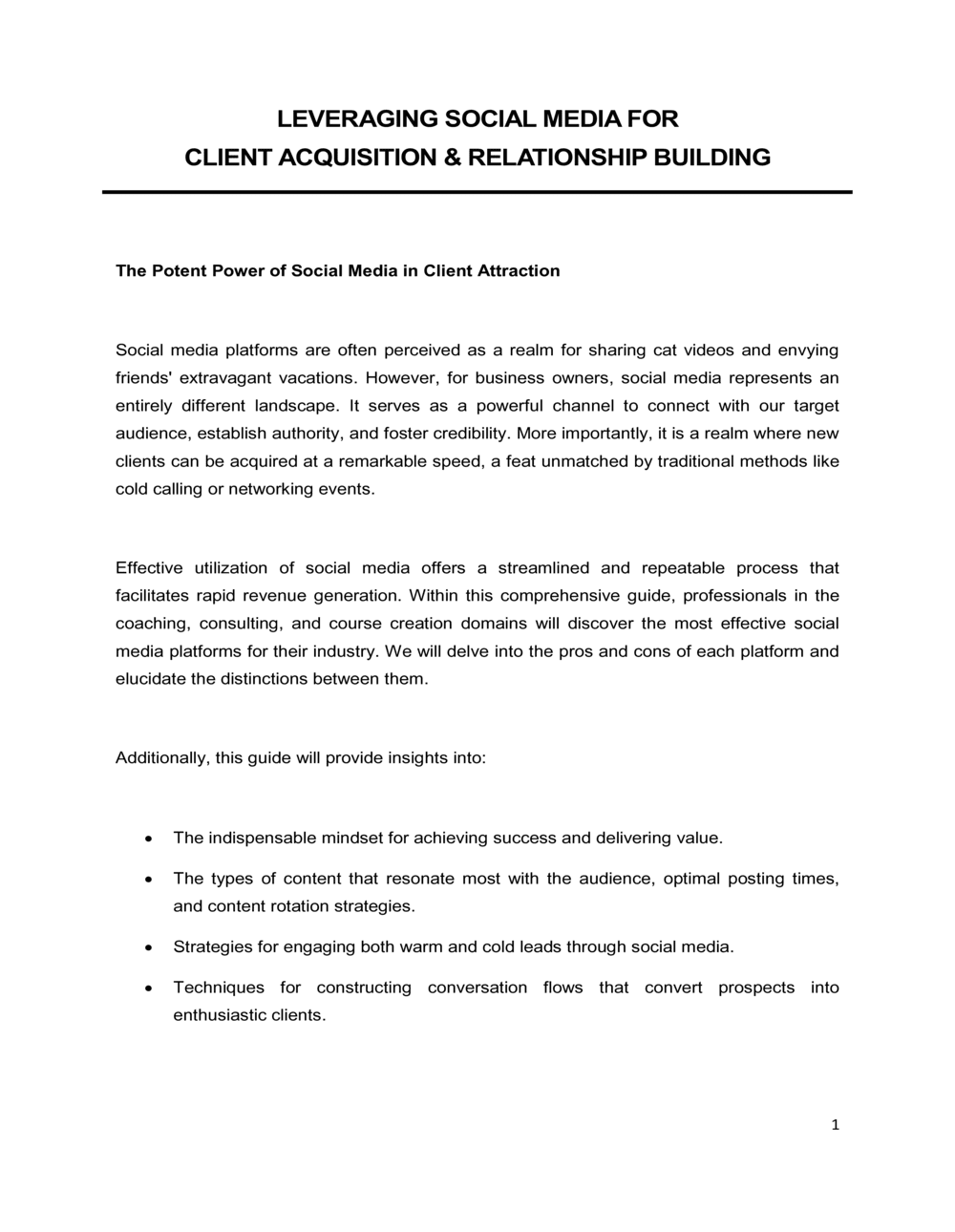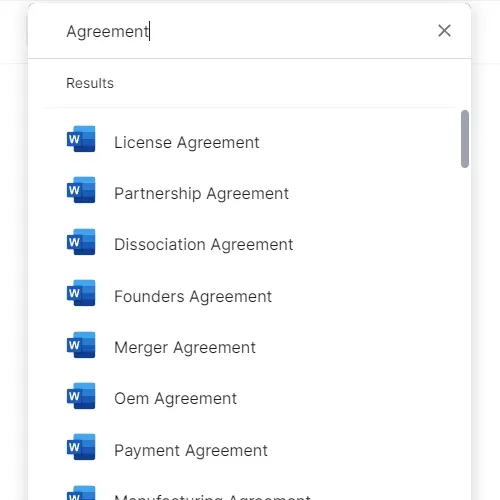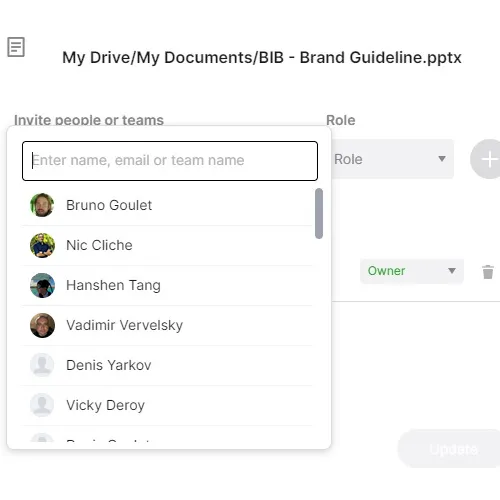Leveraging Social Media For Client Acquisition and Relationship Building Template

Document content
This leveraging social media for client acquisition and relationship building template has 11 pages and is a MS Word file type listed under our sales & marketing documents.
Sample of our leveraging social media for client acquisition and relationship building template:
LEVERAGING SOCIAL MEDIA FOR CLIENT ACQUISITION & RELATIONSHIP BUILDING The Potent Power of Social Media in Client Attraction Social media platforms are often perceived as a realm for sharing cat videos and envying friends' extravagant vacations. However, for business owners, social media represents an entirely different landscape. It serves as a powerful channel to connect with our target audience, establish authority, and foster credibility. More importantly, it is a realm where new clients can be acquired at a remarkable speed, a feat unmatched by traditional methods like cold calling or networking events. Effective utilization of social media offers a streamlined and repeatable process that facilitates rapid revenue generation. Within this comprehensive guide, professionals in the coaching, consulting, and course creation domains will discover the most effective social media platforms for their industry. We will delve into the pros and cons of each platform and elucidate the distinctions between them. Additionally, this guide will provide insights into: The indispensable mindset for achieving success and delivering value. The types of content that resonate most with the audience, optimal posting times, and content rotation strategies. Strategies for engaging both warm and cold leads through social media. Techniques for constructing conversation flows that convert prospects into enthusiastic clients. Given the wealth of information contained herein, it is advisable to keep this guide within easy reach for quick reference. With that said, let us delve into the world of social selling. Facebook and LinkedIn: The Social Media Powerhouses In the realm of social media, Facebook and LinkedIn emerge as the undisputed giants, especially for professionals in coaching, consulting, and course creation. Facebook, with over 2.7 billion users, boasts unparalleled reach and user-friendly features. LinkedIn, designed for business professionals, exudes a more formal and business-centric aura, making it ideal for networking within this niche. Let us begin with Facebook, which stands as the world's largest and most widespread social media network. Facebook offers a diverse user base and serves as a formidable advertising platform. Its groups feature, in particular, holds immense potential for professionals. Facebook groups span a wide array of interests and topics, making them an excellent platform for establishing oneself as a credible expert. Active participation, such as posting or commenting within these groups, enables you to gain recognition and top-of-mind recall among potential clients. However, a caveat with Facebook lies in distinguishing genuine prospects from bystanders who lack either the means or the inclination to avail your services. The sheer volume of content on Facebook necessitates strategic efforts to capture the audience's attention. LinkedIn, on the other hand, was explicitly crafted for professionals in the business sphere. The platform radiates an aura of professionalism and primarily focuses on business-related discussions, including sales, marketing, and product launches. It has evolved significantly from its initial role as a digital resume repository to become a dynamic networking hub for professionals. LinkedIn offers both free and paid subscription models. While the free version allows limited messaging capabilities and search functionalities, the paid Sales Navigator subscription provides advanced tools and features for prospecting. Deciding between the free and paid versions depends on your specific needs and budget. LinkedIn also boasts a robust group system, akin to Facebook. Moreover, LinkedIn rewards content creators by granting posts a longer "shelf life," ensuring greater visibility over time compared to other platforms. In summary, Facebook and LinkedIn are potent platforms for client acquisition, each catering to distinct business models. Facebook shines for business-to-consumer (B2C) offerings, given its massive consumer user base. Conversely, LinkedIn serves as a goldmine for business-to-business (B2B) professionals. A well-rounded approach might involve exploring both platforms to determine which aligns better with your business goals. What Sets Social Media Apart from Conventional Client Acquisition Methods? The pursuit of client acquisition takes various forms across different industries, with countless strategies yielding varying degrees of success. However, the ultimate goal is to secure a consistent stream of clients, reliable sales, and sustainable growth. In this chapter, we will explore some common client acquisition methods often employed by professionals in coaching, consulting, and course creation. Each method possesses its merits and demerits. However, we will elucidate why social media, when wielded effectively, stands out as a superior choice for achieving these objectives. Key factors to consider when evaluating client acquisition methods include: Personability: The ability to convey a personal touch in your approach. Direct Access to Decision Makers: The ease of reaching key decision makers. Scalability: The potential for expansion and growth. Team Building: The feasibility of building a team around the method. Bottleneck Effect: The risk of becoming a bottleneck to business growth. Cold Calling: Cold calling, although it exhibits a personal touch through voice interactions, often yields limited results. It requires significant effort, as you may need to make numerous calls before reaching decision makers. Additionally, cold calls can result in rejections or even hostility. This method is less scalable and can make you the bottleneck in your own business. Cold Email: Cold email, while highly scalable and effective in reaching decision makers, requires meticulous management to avoid spam filters. It entails follow-up emails to secure responses. The process of finding relevant email addresses can be time-consuming. Public Networking Events: Networking events, although valuable for building personal connections, involve travel, costs, and infrequent occurrences. Networking at such events can be daunting, especially for introverts. Social Media: Social media, unlike other methods, combines the personal touch of cold calling, the scalability of cold emailing, and the networking capacity of public events. It allows you to engage prospects organically, showcasing your expertise. Social media interactions eliminate the need for scripts, fostering authentic conversations. In essence, social media marketing is a comprehensive client acquisition method that excels in various aspects compared to traditional methods. Its straightforwardness, scalability, and effectiveness make it an ideal choice for professionals in the modern era. Cultivating a Successful Social Selling Mindset This section may be concise, but it holds paramount importance in your social media journey. The mindset you bring to social media can significantly impact your success. When approaching social media, avoid the sole intent of pitching your services. Instead, aim to establish yourself as an expert and resource in your niche. Focus on delivering value and helping others rather than conveying neediness for sales. Your goal is to lead individuals through their problems rather than making them feel pressured. Effective attitudes to cultivate include: A strong belief in your expertise and professionalism. A genuine desire to provide value to those in need. A lack of neediness or desperation for clients. A willingness to guide others through their challenges. With these principles in mind, you can become a helpful, credible authority on social media. Embracing this mindset will prove instrumental in your journey toward successful social selling. Crafting Engaging Social Media Content and Posting Strategy Regularly posting high-quality content is the cornerstone of your social media marketing plan
Reviewed on

Document content
This leveraging social media for client acquisition and relationship building template has 11 pages and is a MS Word file type listed under our sales & marketing documents.
Sample of our leveraging social media for client acquisition and relationship building template:
LEVERAGING SOCIAL MEDIA FOR CLIENT ACQUISITION & RELATIONSHIP BUILDING The Potent Power of Social Media in Client Attraction Social media platforms are often perceived as a realm for sharing cat videos and envying friends' extravagant vacations. However, for business owners, social media represents an entirely different landscape. It serves as a powerful channel to connect with our target audience, establish authority, and foster credibility. More importantly, it is a realm where new clients can be acquired at a remarkable speed, a feat unmatched by traditional methods like cold calling or networking events. Effective utilization of social media offers a streamlined and repeatable process that facilitates rapid revenue generation. Within this comprehensive guide, professionals in the coaching, consulting, and course creation domains will discover the most effective social media platforms for their industry. We will delve into the pros and cons of each platform and elucidate the distinctions between them. Additionally, this guide will provide insights into: The indispensable mindset for achieving success and delivering value. The types of content that resonate most with the audience, optimal posting times, and content rotation strategies. Strategies for engaging both warm and cold leads through social media. Techniques for constructing conversation flows that convert prospects into enthusiastic clients. Given the wealth of information contained herein, it is advisable to keep this guide within easy reach for quick reference. With that said, let us delve into the world of social selling. Facebook and LinkedIn: The Social Media Powerhouses In the realm of social media, Facebook and LinkedIn emerge as the undisputed giants, especially for professionals in coaching, consulting, and course creation. Facebook, with over 2.7 billion users, boasts unparalleled reach and user-friendly features. LinkedIn, designed for business professionals, exudes a more formal and business-centric aura, making it ideal for networking within this niche. Let us begin with Facebook, which stands as the world's largest and most widespread social media network. Facebook offers a diverse user base and serves as a formidable advertising platform. Its groups feature, in particular, holds immense potential for professionals. Facebook groups span a wide array of interests and topics, making them an excellent platform for establishing oneself as a credible expert. Active participation, such as posting or commenting within these groups, enables you to gain recognition and top-of-mind recall among potential clients. However, a caveat with Facebook lies in distinguishing genuine prospects from bystanders who lack either the means or the inclination to avail your services. The sheer volume of content on Facebook necessitates strategic efforts to capture the audience's attention. LinkedIn, on the other hand, was explicitly crafted for professionals in the business sphere. The platform radiates an aura of professionalism and primarily focuses on business-related discussions, including sales, marketing, and product launches. It has evolved significantly from its initial role as a digital resume repository to become a dynamic networking hub for professionals. LinkedIn offers both free and paid subscription models. While the free version allows limited messaging capabilities and search functionalities, the paid Sales Navigator subscription provides advanced tools and features for prospecting. Deciding between the free and paid versions depends on your specific needs and budget. LinkedIn also boasts a robust group system, akin to Facebook. Moreover, LinkedIn rewards content creators by granting posts a longer "shelf life," ensuring greater visibility over time compared to other platforms. In summary, Facebook and LinkedIn are potent platforms for client acquisition, each catering to distinct business models. Facebook shines for business-to-consumer (B2C) offerings, given its massive consumer user base. Conversely, LinkedIn serves as a goldmine for business-to-business (B2B) professionals. A well-rounded approach might involve exploring both platforms to determine which aligns better with your business goals. What Sets Social Media Apart from Conventional Client Acquisition Methods? The pursuit of client acquisition takes various forms across different industries, with countless strategies yielding varying degrees of success. However, the ultimate goal is to secure a consistent stream of clients, reliable sales, and sustainable growth. In this chapter, we will explore some common client acquisition methods often employed by professionals in coaching, consulting, and course creation. Each method possesses its merits and demerits. However, we will elucidate why social media, when wielded effectively, stands out as a superior choice for achieving these objectives. Key factors to consider when evaluating client acquisition methods include: Personability: The ability to convey a personal touch in your approach. Direct Access to Decision Makers: The ease of reaching key decision makers. Scalability: The potential for expansion and growth. Team Building: The feasibility of building a team around the method. Bottleneck Effect: The risk of becoming a bottleneck to business growth. Cold Calling: Cold calling, although it exhibits a personal touch through voice interactions, often yields limited results. It requires significant effort, as you may need to make numerous calls before reaching decision makers. Additionally, cold calls can result in rejections or even hostility. This method is less scalable and can make you the bottleneck in your own business. Cold Email: Cold email, while highly scalable and effective in reaching decision makers, requires meticulous management to avoid spam filters. It entails follow-up emails to secure responses. The process of finding relevant email addresses can be time-consuming. Public Networking Events: Networking events, although valuable for building personal connections, involve travel, costs, and infrequent occurrences. Networking at such events can be daunting, especially for introverts. Social Media: Social media, unlike other methods, combines the personal touch of cold calling, the scalability of cold emailing, and the networking capacity of public events. It allows you to engage prospects organically, showcasing your expertise. Social media interactions eliminate the need for scripts, fostering authentic conversations. In essence, social media marketing is a comprehensive client acquisition method that excels in various aspects compared to traditional methods. Its straightforwardness, scalability, and effectiveness make it an ideal choice for professionals in the modern era. Cultivating a Successful Social Selling Mindset This section may be concise, but it holds paramount importance in your social media journey. The mindset you bring to social media can significantly impact your success. When approaching social media, avoid the sole intent of pitching your services. Instead, aim to establish yourself as an expert and resource in your niche. Focus on delivering value and helping others rather than conveying neediness for sales. Your goal is to lead individuals through their problems rather than making them feel pressured. Effective attitudes to cultivate include: A strong belief in your expertise and professionalism. A genuine desire to provide value to those in need. A lack of neediness or desperation for clients. A willingness to guide others through their challenges. With these principles in mind, you can become a helpful, credible authority on social media. Embracing this mindset will prove instrumental in your journey toward successful social selling. Crafting Engaging Social Media Content and Posting Strategy Regularly posting high-quality content is the cornerstone of your social media marketing plan
Easily Create Any Business Document You Need in Minutes.

Download or open template
Access over 3,000+ business and legal templates for any business task, project or initiative.

Edit and fill in the blanks
Customize your ready-made business document template and save it in the cloud.

Save, Share, Export, or Sign
Share your files and folders with your team. Create a space of seamless collaboration.



